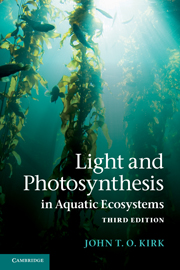Preface to the third edition
Published online by Cambridge University Press: 05 January 2013
Summary
Preface to the third edition
Four things are required for plant growth: energy in the form of solar radiation; inorganic carbon in the form of carbon dioxide or bicarbonate ions; mineral nutrients; and water. Those plants which, in the course of evolution, have remained in, or have returned to, the aquatic environment have one major advantage over their terrestrial counterparts: namely, that water – lack of which so often limits productivity in the terrestrial biosphere – is for them present in abundance; but for this a price must be paid. The medium – air – in which terrestrial plants carry out photosynthesis offers, within the sort of depth that plant canopies occupy, no significant obstacle to the penetration of light. The medium – water – in which aquatic plants occur, in contrast, both absorbs and scatters light. For the phytoplankton and the macrophytes in lakes and rivers, coastal and oceanic waters, both the intensity and spectral quality of the light vary markedly with depth. In all but the shallowest waters, light availability is a limiting factor for primary production by the aquatic ecosystem. The aquatic plants must compete for solar radiation not only with each other (as terrestrial plants must also do), but also with all the other light-absorbing components of the aquatic medium. This has led, in the course of evolution, to the acquisition by each of the major groups of algae of characteristic arrays of light-harvesting pigments that are of great biochemical interest, and also of major significance for an understanding both of the adaptation of the algae to their ecological niche and of the phylogeny and taxonomy of the different algal groups. Nevertheless, in spite of the evolution of specialized light-harvesting systems, the aquatic medium removes so much of the incident light that aquatic ecosystems are, broadly speaking, less productive than terrestrial ones.
- Type
- Chapter
- Information
- Light and Photosynthesis in Aquatic Ecosystems , pp. ix - xiiPublisher: Cambridge University PressPrint publication year: 2010



